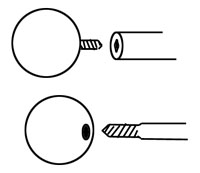Exsanguinate and External Threading: Difference between pages
(Difference between pages)
Jump to navigation
Jump to search
(Page conversion via llm-mediawiki-rev -jwm) |
(Page conversion via llm-mediawiki-rev -jwm) |
||
| Line 1: | Line 1: | ||
[[File: | [[File:Threading.jpg|right|200px]] | ||
[Barbells] are attached to [beads] via threaded rods. How they attach can vary. | |||
There are two main kinds of '''threading''' used in the [body modification] industry. The top drawing shows an internally threaded barbell, where the bead screws into the bar. The bottom drawing shows an externally threaded barbell, where the bar screws into the bead. A subtype of external threading is step-down threading, where the threaded portion is of a smaller gauge than the main stem of the barbell - this can help prevent the threads catching on the [fistula] during insertion. | |||
Latest revision as of 03:26, 17 September 2023
[Barbells] are attached to [beads] via threaded rods. How they attach can vary.
There are two main kinds of threading used in the [body modification] industry. The top drawing shows an internally threaded barbell, where the bead screws into the bar. The bottom drawing shows an externally threaded barbell, where the bar screws into the bead. A subtype of external threading is step-down threading, where the threaded portion is of a smaller gauge than the main stem of the barbell - this can help prevent the threads catching on the [fistula] during insertion.
